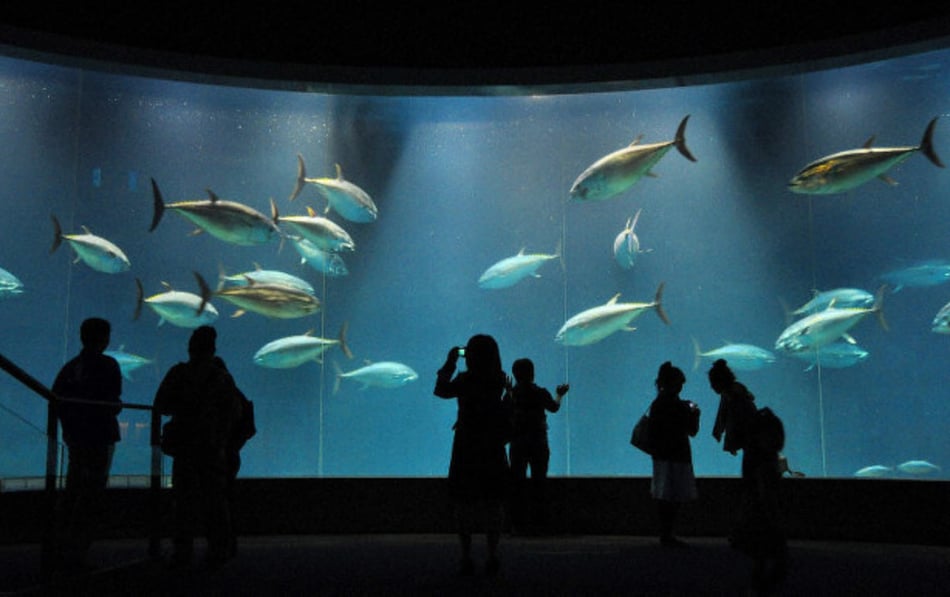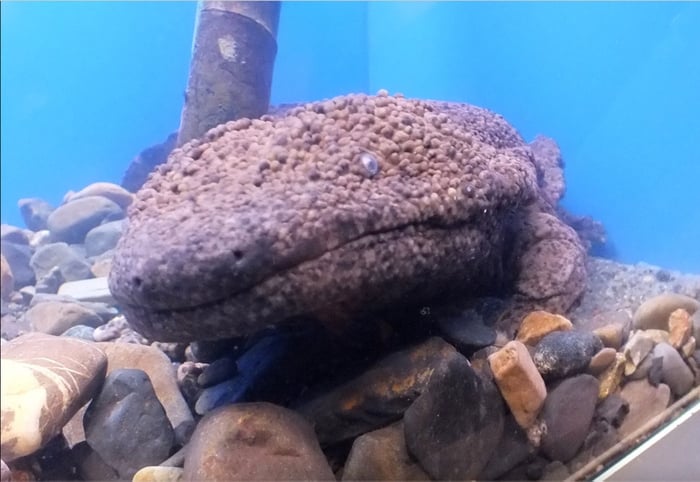Japan's Aquariums Redefine Underwater Exploration

Tin
4
min. read

In Japan, there are numerous major aquariums and many other smaller aquatic attractions. These underwater portals showcase a diverse array of marine life, innovative exhibits, and immersive experiences, making them popular destinations for both locals and tourists alike.
Below are three of the most interesting and important aquariums in Japan for tourists - and locals - to visit.
Below are three of the most interesting and important aquariums in Japan for tourists - and locals - to visit.
 Whale sharks swimming around the Kuroshio Sea tank
Whale sharks swimming around the Kuroshio Sea tank
Okinawa Churaumi Aquarium
Nestled in the picturesque island of Okinawa, Japan, lies the awe-inspiring Okinawa Churaumi Aquarium. Home to an impressive array of marine life and rare finds, this world-class aquarium stands as a testament to Japan's commitment to marine conservation and education.
One of the crown jewels of the Okinawa Churaumi Aquarium is the massive Kuroshio Sea tank, which, at nearly 3 meters (9 feet) tall and 10 meters (30 feet) deep, is the world’s third-largest aquarium tank. Within this tank, visitors can witness the dance of manta rays (Manta birostris) and whale sharks (Rhincodon typus) alongside a plethora of more than 80 different kinds of corals, which, incidentally, is the world’s largest living coral exhibit.
Whale sharks are the largest fish species on Earth, known for their immense size and gentle nature. These giants can grow up to 12 to 18 meters (38 to 60 feet) in length and weigh up to 40 metric tons. In the Kuroshio Sea tank, visitors can witness these gentle giants gliding through the water, seemingly weightless despite their massive size. The aquarium has the distinction of being the first in the world to successfully breed whale sharks in captivity, currently housing three of these majestic creatures. Among them, "Jinta" stands out as the largest, and since his arrival in 1995, he holds the impressive record for the longest time kept in captivity for a whale shark.
Another exciting aspect of the Kuroshio Sea experience is the exclusive behind-the-scenes observation tour. This tour offers visitors the chance to view the massive tank from an observation platform suspended above, where they can marvel at the sight of the fish swimming beneath their feet and possibly catch a glimpse into the feeding practices of whale sharks.
Finally, the aquarium also houses the Shark Research Lab. The primary goal of the lab is to conduct in-depth research on different shark species, including those found in the Kuroshio Current and the surrounding waters of Okinawa. The lab also focuses on shark breeding and husbandry programs, aimed at understanding the reproductive biology of various shark species. By successfully breeding and raising sharks in captivity, scientists can gather valuable data on their early life stages, growth rates, and health conditions.

Giant Salamander through the glass of the Kyoto aquarium
Kyoto Aquarium
The Kyoto Aquarium invites visitors on a captivating journey through nine different aquatic zones, each brimming with a diverse array of marine life from around the world. At the heart of this aquatic wonderland lies a special resident: the Japanese giant salamander, a captivating creature that has endeared the hearts of visitors.
The nine different zones of the aquarium showcase different environments which house their respective ecosystem of marine life. Some of these include the Sea of Japan Zone, which fittingly showcases marine life from the Sea of Japan, including crabs, fish, and jellyfish, and the Amazon Zone, which shows life from the Amazon River Basin, including piranhas, caimans, and turtles. However, the zone that captures the hearts of many is the Rivers of Kyoto Zone because this houses the aforementioned giant salamander (andrias japonicus).
Endemic to Japan and China (hence the names Japanese giant salamander and Chinese giant salamander), these rare giants are the largest amphibians in the world, reaching lengths of up to 1.5 meters (5 feet). Within the aquarium's carefully designed habitat, visitors can observe these giants up close, gaining insights into their unique characteristics and behaviors. The mottled skin and distinctive facial features of giant salamanders make them truly remarkable to behold; they are elusive by nature and tend to hide in underwater burrows or under rocks during the day, making them challenging to spot in the wild. It is a truly rare opportunity to be able to observe them within the aquarium.
The nine different zones of the aquarium showcase different environments which house their respective ecosystem of marine life. Some of these include the Sea of Japan Zone, which fittingly showcases marine life from the Sea of Japan, including crabs, fish, and jellyfish, and the Amazon Zone, which shows life from the Amazon River Basin, including piranhas, caimans, and turtles. However, the zone that captures the hearts of many is the Rivers of Kyoto Zone because this houses the aforementioned giant salamander (andrias japonicus).
Endemic to Japan and China (hence the names Japanese giant salamander and Chinese giant salamander), these rare giants are the largest amphibians in the world, reaching lengths of up to 1.5 meters (5 feet). Within the aquarium's carefully designed habitat, visitors can observe these giants up close, gaining insights into their unique characteristics and behaviors. The mottled skin and distinctive facial features of giant salamanders make them truly remarkable to behold; they are elusive by nature and tend to hide in underwater burrows or under rocks during the day, making them challenging to spot in the wild. It is a truly rare opportunity to be able to observe them within the aquarium.
The Kyoto Aquarium plays a vital role in the conservation and preservation of giant salamanders by providing a suitable environment that mimics their natural habitat and ensuring proper care and nutrition. The aquarium also contributes to the well-being and reproduction of these extraordinary amphibians. Through educational programs and interactive displays, visitors not only gain a deeper appreciation for the giant salamander's importance in Japan's aquatic ecosystems but also become aware of the need to protect and conserve these incredible creatures and their habitats. The giant salamander exhibit at the Kyoto Aquarium serves as a powerful reminder of the significance of preserving biodiversity and underscores the importance of responsible environmental stewardship for future generations.

Tuna swimming around in the donut-shaped tank of the Tokyo Sea Life Park
Tokyo Sea Life Park
The Tokyo Sea Life Aquarium features a variety of marine exhibits, allowing visitors to explore the different coastal habitats surrounding Japan. From the coastal environments of the Izu Islands to the coral reefs of Ogasawara, the aquarium highlights the rich diversity of marine life in the region. Notably, the giant kelp tank presents an awe-inspiring display of these towering underwater plants, creating a captivating atmosphere for visitors.
At the Tokyo Sea Life Aquarium, one of the most impressive attractions is the gigantic donut-shaped tuna tank, which can hold a whopping 2,200 metric tons of water. This tank is specifically designed to mimic the natural swimming patterns of bluefin and yellowfin tunas, providing them with a space to roam freely and comfortably. The unique cylindrical shape of the tank offers visitors a 360-degree view, giving the sensation of being surrounded by these majestic oceanic fish as they gracefully swim around. This is the world's first aquarium to successfully showcase tunas swimming and reproducing freely together within such an environment.
Japan's diverse aquarium offerings provide a figurative (and literal) deep dive into the marvels of marine life. These aquariums play a significant role in fostering understanding and appreciation of the aquatic world, showcasing unique marine species while also driving home the critical importance of conservation efforts. Visiting these awe-inspiring aquariums not only offers an enjoyable and educational experience but also encourages us to value and protect the enchanting world beneath our oceans.
IMARCS shares the vision and mission fostered by the aquariums covered above, as we work towards a more prosperous tomorrow, where sustainable aquaculture and marine science improve marine environments and inspire hope for a better future.
Together we can make a real, positive, and measurable impact on our beloved planet.
Sources:
Barnes, C. (2013, July 26). The Kuroshio Sea, A Mesmerizing Underwater World. JapanTravel. https://en.japantravel.com/okinawa/the-kuroshio-sea/5786
Rhincodon typus. Discover Fishes. (2020). https://www.floridamuseum.ufl.edu/discover-fish/species-profiles/rhincodon-typus/
Kroeger, K. (2023, June 9). Complete Guide to Okinawa Churaumi Aquarium. ViaTravelers. https://viatravelers.com/sea-okinawa-churaumi-aquarium/
Japanese giant salamander in Kyoto. Setouchi Explorer. (2014a, July 7). https://www.setouchiexplorer.com/japanese-giant-salamander-kyoto/
Tokyo sea life park is the best with cheaper admission fee. TOKYO TOURISTS. (2023, May 6). https://tokyotourists.com/tokyo-sea-life-park/
A must-try aquarium experience in Japan: The Tokyo Sea Life Park!. WeXpats Guide. (2020, October 29). https://we-xpats.com/en/guide/as/jp/detail/4032/